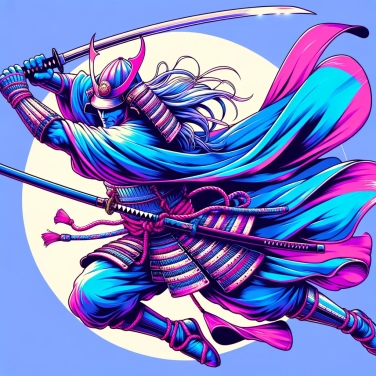Japanese samurais carried katanas as their main weapon due to their effectiveness in close combat, high precision, and the symbolism associated with honor and warrior tradition.

In Japan, starting from the Kamakura period (1185-1333), samurai adopted the katana as their main weapon due to the numerous internal conflicts and close skirmishes that required a reactive and quick-drawing weapon. At that time, battles often took place in confined spaces or on horseback, where a curved, lightweight, and sharp blade was ideal for cutting and striking effectively without losing time. The katana quickly proved superior to the longer and straighter swords imported from China or Korea, as its curvature allowed for fluid handling and precise cutting, even with one hand. Gradually, the katana thus became both an effective military weapon for quick duels and the ultimate symbol of the Japanese warrior throughout the entire Japanese feudal period.
The katana has several technical properties that explain its popularity among samurai. Its blade is curved, facilitating a natural motion for slicing. Forged using a complex folding technique, it wonderfully combines a high hardness on the outside (very sharp edge) with a certain flexibility on the inside, which prevents it from breaking easily. It is this subtle balance between flexibility and hardness that makes it particularly resistant yet lightweight. Its razor-sharp blade allows for extremely precise and lethal strikes in a single motion. In terms of maneuverability, its size (generally around 70 cm on average for the blade) offers an ideal reach while allowing for quick two-handed handling, perfect for a swift and effective attack. Samurai thus appreciated the speed, reliability, and surgical precision of the katana, far surpassing the raw power of other weapons.
For the samurai, the katana was much more than just a weapon; it was truly an extension of their soul. It represented honor, identity, and social rank. It was the exclusive weapon of the samurai, the only ones allowed to carry it permanently, which clearly reflected their status and role in Japanese society. This blade also symbolized Bushido, the famous moral code of the warriors based on values such as loyalty, courage, and discipline. Some samurai even believed that their katanas contained the spirit of their ancestors and passed them down from generation to generation as a sign of familial continuity. Therefore, losing or abandoning one's katana meant losing one's honor, the worst shame for a samurai.
The katana was a balanced and effective weapon, especially for quick close combat. Compared to the yari (spear), which had the obvious advantage of range, the katana offered more mobility and precision in close quarters or confined spaces. While the bow (yumi) had formidable power at a distance, once in close range it was finished: impossible to use effectively in close combat. As for the short sword (wakizashi), useful in tight spaces or indoors, it clearly lacked reach against well-trained opponents. The katana therefore combined the best of both worlds: sufficient range to avoid being too exposed, surgical precision, and agile handling, ideal for a samurai capable of quickly adapting to any situation.
The katana is traditionally forged by folding the steel several times, sometimes up to fifteen layers, which makes the blade particularly strong, flexible, and sharp.
The daisho is a pair of swords consisting of a large katana and a small wakizashi, which only samurai were allowed to wear together as a distinctive sign of their social rank.
The katana was not just a weapon; it was a spiritual object. Some samurai believed that their sword contained their soul and honored their katana with respect, placing it even near their bed while they slept.
According to legend, some Japanese master craftsmen tested the quality of their freshly forged blades by immersing them in flowing waters and observing whether a floating leaf could be sliced simply by the current.
Bushido, or 'the way of the warrior', refers to a set of moral principles governing the lives of the samurai. Among its values were loyalty, honor, and self-mastery. The katana, a physical symbol of this honor, was to be treated with respect and mastery, representing both personal discipline and commitment to the service of the lord (daimyo).
Yes, the samurai mastered various weapons such as the bow (yumi), the spear (yari), the short sword (wakizashi), and often even the halberd (naginata). However, the katana remained the primary weapon due to its versatility in close combat and its strong symbolic significance.
For the samurai, the katana was not merely a weapon. It embodied their soul, their honor, and their social status. Receiving a katana was an important symbolic event that marked the entry into the warrior class and represented loyalty to bushido.
The traditional manufacturing of a Japanese katana involved a complex process that included the repeated folding of the steel blade to enhance its strength and durability. This technique required advanced craftsmanship that combined strength, exceptional sharpness, and flexibility, making each katana unique.
The Japanese katana features a curved and sharp blade designed primarily for quick and precise cuts, while Western sabers were often heavier and suited for thrusting and striking actions. The katana was generally lighter and more maneuverable, allowing samurai to perform fluid and precise movements.

No one has answered this quiz yet, be the first!' :-)
Question 1/5